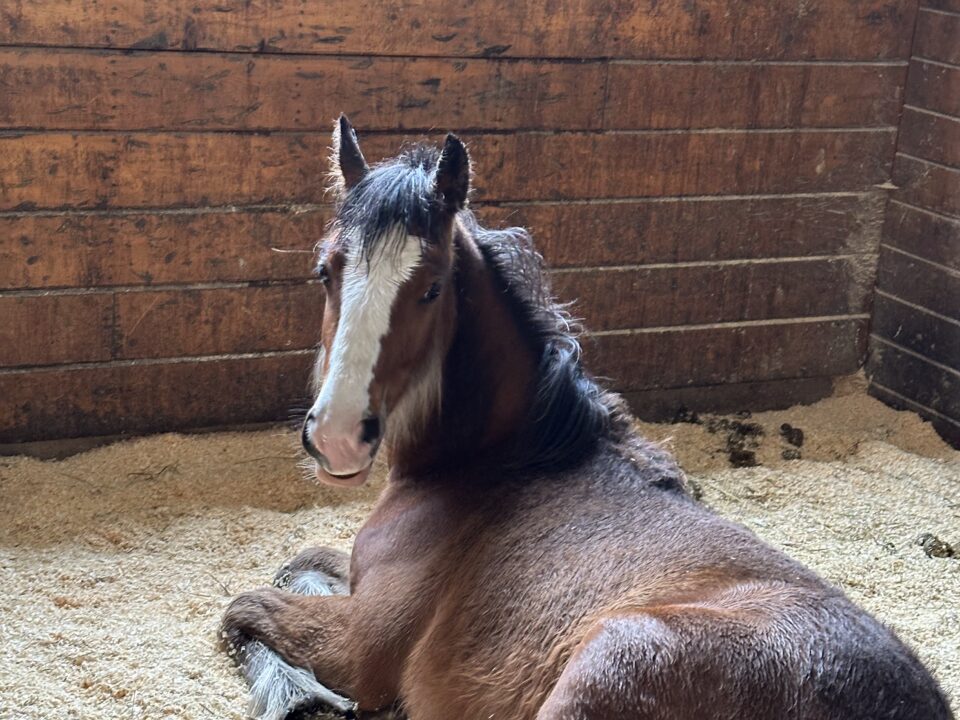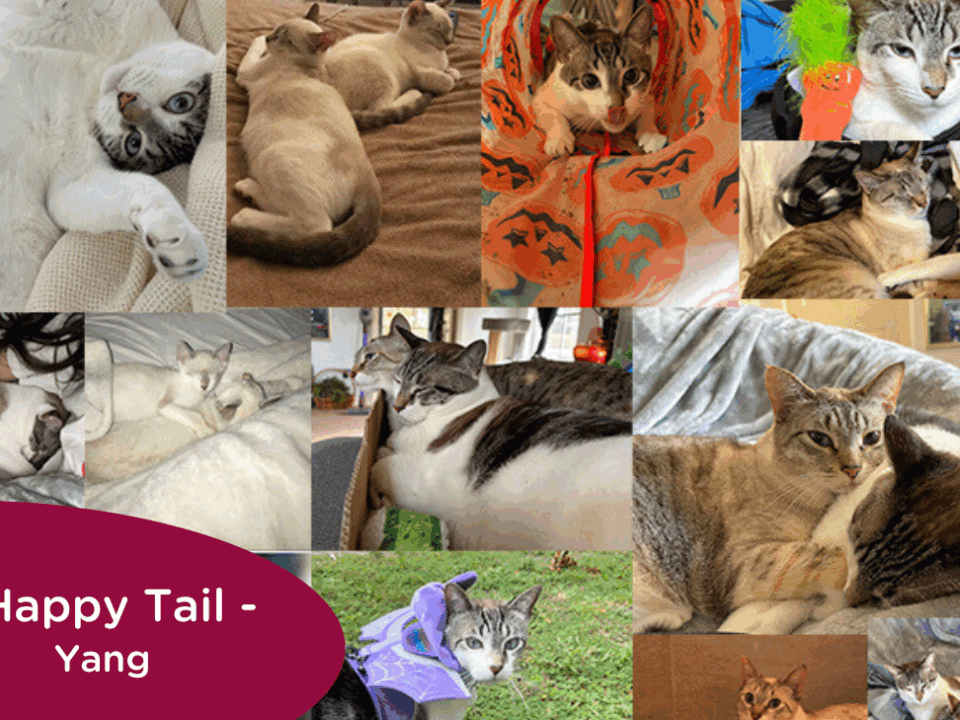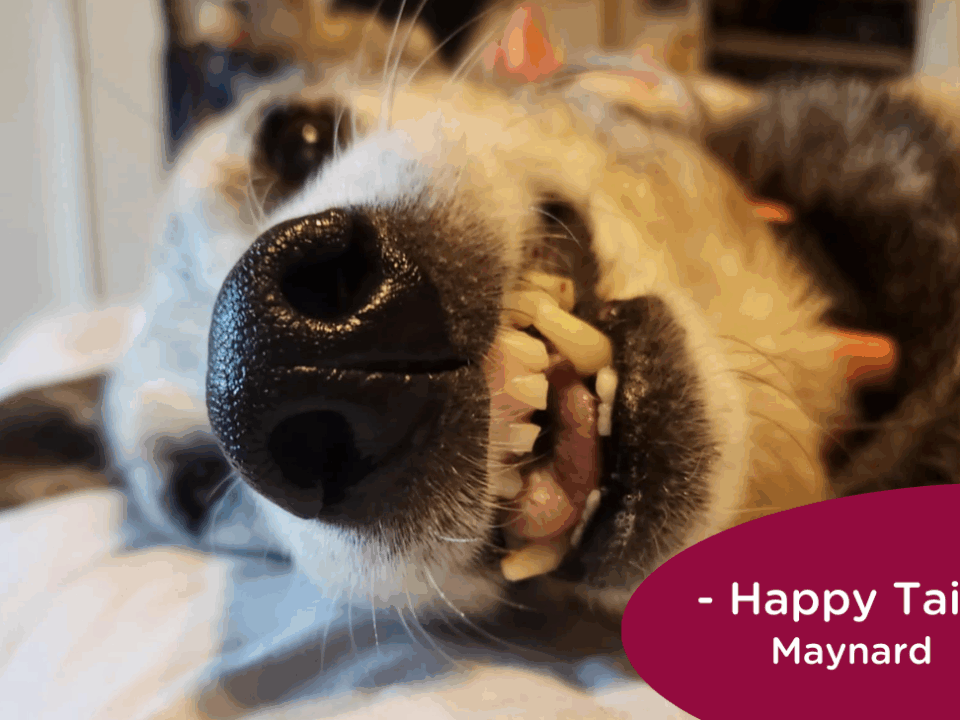Madison County Cats: Interview with Andy Bass
March 20th, 2012
Marcia Goodman, RedRover Responders volunteer and Communications Assistant, interviews Andy Bass on the RedRover Responders deployment to Madison County, Florida.
A RedRover volunteer since the mid-1990s, and often a RedRover Responders Team Leader, Andy Bass deployed to the emergency cat shelter in Jacksonville, Florida, with the Bay Area Disaster Animal Response Team (DART), part of Florida’s State Animal Response Coalition. Because Andy is so much a part of RedRover and embodies RedRover’s values – working in cooperation with other people and other organizations to help animals – we are featuring him in this volunteer spotlight.
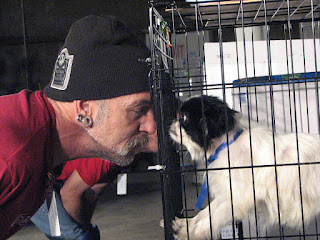 |
| Andy Bass and a puppy mill dog illustrate the human-animal bond. Photo by RedRover Responders volunteer and Communications Assistant Tracy Clark. |
I met Andy for the first time during this deployment and almost immediately realized that he’s a role model for RedRover Responders volunteers and an inspiration to people who are already volunteering or are considering it. I’ve been to a number of deployments with RedRover; yet, when I was teamed with Andy on one of the first days here, he taught me a lot in a very positive and supportive way. Andy has an abundance of talent, knowledge and experience, combined with teaching and mentoring skills, an outgoing personality, a bit of flamboyance and a deep, deep dedication to helping animals. I interviewed Andy at the end of a long day at the Jacksonville, Florida, cat emergency shelter.
Marcia: Tell me a little bit about your background. When did you first start helping animals?
Andy: When I was about 11 years old, a large German shepherd came upon me while I was playing outside. He was taller than me, and instead of either of us being scared, he sat down next to me. I took him home and asked my mother if we could keep him. She said we couldn’t, but we could get the dog a good home by calling the animal shelter. Later that day, a woman from the animal shelter came by and took the dog with her.
I never heard about that dog again, but that made me aware that animal shelters find good homes for animals. Because of that experience, when I was in college and wanted a dog, I went to the animal shelter and adopted a dog from them. I was aware that I could do more than go into a pet store and buy a dog.
Marcia: What got you into animal rescue?
Andy: When I met my life partner, she had a standard poodle and I had my corgi, and we started to foster standard poodles and corgis. We worked on that for about 10 years, taking in animals and then placing them. I became involved in what was then the only poodle rescue group in Florida, and then I helped found the Coastal Poodle Rescue.
When Hurricane Andrew hit, I got into disaster relief. Miami/Dade was devastated, and many people deserted the area. A number of them dumped their dogs onto highway off ramps in Broward County where I live. That’s when I realized there’s a need for people to get involved in rescue, foster, and rehabilitation of dogs.
Marcia: How did you get involved with RedRover?
Andy: RedRover Responders was then known as Emergency Animal Rescue Service (EARS). They were at Hurricane Andrew, and their practice after a disaster was to come back a couple of years later to offer training to prospective volunteers. EARS was about the only organized group working for animals in disasters back then. The rest of disaster services for animals were informal and very disorganized. Before I was involved with EARS, I remember being part of a care caravan bringing supplies to a disaster area. The car I was given overheated and I had to leave the caravan and make my own plan to get the supplies in my vehicle to people in need. After that experience, I realized that if I was going to respond to disasters, I had to get into an organization that knows what it’s doing so I wouldn’t be a victim. That’s why I became active with RedRover.
Marcia: So you signed up with RedRover Responders?
Andy: Yes, I took their training in 1996. I wasn’t deployed by them until 2004 because there weren’t any disasters in our region during that time. When they did call, I went scurrying to find my red shirt and manual.
It was different back then. There was no PetSmart Charities to help with supplies, and each volunteer brought tools, supplies, dog food, anything we needed, and we headed to Bartow, Florida. We arrived in the middle of the night and pitched a tent. It turns out the incident commander on that deployment was a woman I’d gone to the EARS training with, and it was like old home week.
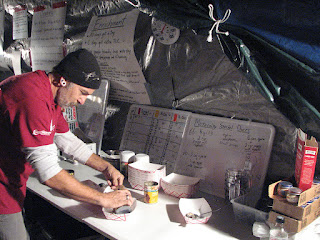 |
| Andy Bass prepares meals during our 2011 deployment to a puppy mill in Kentucky. Photo by Tracy Clark. |
Marcia: Why do you volunteer for emergency rescues?
Andy: Because when we were in need, others helped us, and I knew how important it was to see teams of volunteers coming in from out of state. I knew I had to reciprocate. Helping others in their time of crisis was a way of showing how much I appreciated their help.
Marcia: Why didn’t you volunteer with the Red Cross given that they were the largest disaster relief agency?
Andy: There were already people doing the human side of things. RedRover Responders was like the Red Cross for animals, and I’m an animal person. I always have been. I was ready to create temporary emergency shelters for animals. I’d been kennel manager of an animal hospital, and I’d already been involved with producing large-scale outdoor music festivals. I could use what I’d learned and apply it to the responses. Each festival involved planning for months and running it for a few days; with a disaster, you plan for a few days and run it for months.
Marcia: I’m sure you’ve seen similarities and differences among deployments. Would you give us your sense of those?
Andy: The similarities among all the deployments are urgency, the need for care, and the need for compassion and protection of the animals who are our charges. Also similar are the volunteers eating junk food, getting little sleep, sharing the corners of barns with strangers who then become friends. Also, in all of them, we have opportunities to learn everything from animal handling to animal issues to just interacting with people and supporting each other and what it means to be on a well-functioning team.
The differences are vast. Every deployment is different and has its own unique challenges. We have to do the same thing every time, but we have to customize it to the location.
The types of deployments have inherent differences. At natural disasters, there’s the knowledge that not only am I helping animals, but also the human victims. In a hoarding case, it’s helping the animals and in an outlying way, helping the hoarder get his or her mental health. In puppy mill deployments, it’s knowing about the “blossom factor,” which is what I call the dogs’ progress from the beginning of the rescue, when they stay in the back of their kennels, over time as they start coming to the front of the cage. We see them blossom and become the animals they’re supposed to be. We see them walk on the grass for the first time in their lives. In dog fight deployments, we’re able to let the dogs experience that there are nice humans in the world, at least while under RedRover’s care. Even if they don’t make it because they’re trained fighters, we’re able to give them a gift of compassion at the end of their lives.
Marcia: What about this deployment?
Andy: I volunteered for this one, which is all cats, after Gainesville, which was also all cats, even though I’m “dog person” first and cat second. Both deployments have turned me into something of a cat expert. In Gainesville, they assigned me to what they called the “Fractious Room.” I immediately changed the name to “Harmony Hut.” After working there, I felt I gained knowledge, and here in Jacksonville, I was assigned to intake, and you know how hectic intake can be.
I was 100 percent looking forward to coming here. I wanted to make it right for the cats, make good on the promises made to the cats, promises that weren’t kept. I also knew I’d be working with one of the best teams out there, with RedRover, ASPCA and Florida SARC.
 |
| Andy, with his signature grin, preparing food for the Madison County cats. Photo by Marcia Goodman. |
Marcia: Did you go to the Caboodle Ranch site for the rescue?
Andy: No. I’ve been offered opportunities to go out in the field in the past, and although I’m always happy to help in any way that I can, if I have a choice, I’d prefer to prepare the shelter hotel for our incoming guests to make sure we’re ready. That’s my best place.
Marcia: And, finally, what has been most rewarding about this particular deployment, and is there anything that’s frustrated you?
Andy: The rewards are in knowing we’re bringing quality of life to the animals, that they’re going to a better place. Also, it’s always exciting to see people I haven’t seen for a while. It was a big treat the other day when, across the room, I saw someone who I last worked with in 2009, and I’ve seen other RedRover Responders as recently as the Joplin tornado and the Kentucky puppy mill deployments. We’ve become bosom buddies. As for frustration, it’s that we have to be here in the first place. With natural disasters, we have no choice, but this is a person-made disaster, and that shouldn’t be happening.
View Marcia’s photos from this deployment by visiting the RedRover Facebook page.

